Andalusien |
|
|
|
| Übersicht – Contents: | |
Andalusien |
|
|
|
| Übersicht – Contents: | |
Flagge – Flag: |
|
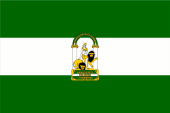 |
Flagge von Andalusien |
| historische und andere Flaggen – historical and other Flags: | |
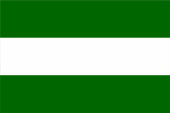 |
1918–1981, |
 |
bis/to 1492, |
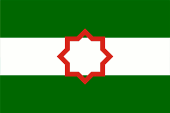 |
Flagge lokaler Nationalisten |
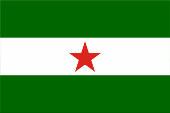 |
Flagge linksgerichteter lokaler Nationalisten |
| Die die heutige Flagge Andalusiens wurde im Jahre 1918 von Blas Infante entworfen. Sie zeigt drei waagerechte Streifen in Grün, Weiß und Grün, und heute das Wappen des Landes in der Mitte des weißen Streifens. Sie wurde am 30.12.1981 offiziell eingeführt. | The today's flag of Andalusia was designed in 1918 by Blas Infante. It shows three horizontal stripes in green, white and green and today the coat of arms of the country in the middle of the white stripe. It was officially introduced on 30th of December in 1981. |
Zur
Erklärung der Bedeutung und des Ursprungs der Farben gibt es sehr viele
Theorien, die sich teilweise widersprechen:
|
For
explanation of meaning and origin of the colours there exist many theories
which contradict each other:
|
| In der Tat spielen grüne und weiß-grüne Flaggen eine gewisse Rolle in der Geschichte des Landes. Die Farben sind seit dem Mittelalter bekannt, scheinen jedoch immer einen inoffiziellen Charakter gehabt zu haben, später, in der spanischen Zeit, sind weiß-grüne Flaggen als Banner anti-spanischer Aufstände von Morisken und Separatisten bekannt. | Indeed
play green and white-green flags a special role in the history of the
country. The colours are known since the Middle Ages, but it seems that they had only an unofficial character, later – in the Spanish times – white-green flags are known as banners of anti-spanish riotings of Moriscos and separatists. |
| Die ersten islamischen Herrscher des Landes, die Kalifen-Dynastie der Omaijaden, verwendeten weiße Flaggen. Über die Flaggen der Almoraviden, seit 1086 an der Macht, ist nichts bekannt. Die Almohaden, die im Jahre 1147 die Macht ergiffen, hätten angeblich weiße Flaggen verwendet, jedoch zeigte die Flagge der Almohaden in der Schlacht von Navas de Tolosa (1212) das überbordende Muster eines reichverzierten orientalischen Teppichs in den Farben Weiß und Rot, verziert mit schwarzer arabischer Schrift. Die Nasriden-Dynastie des Emirats von Granada (1212–1492) verwendete rote Flaggen mit der Schahada, dem Bekenntniswort des Islam ("Allah il Allah, wa Muhammad rasul Allah" → "Es gibt keinen Gott ausgenommen den Gott; Mohammed ist Allahs Gesandter"), oder Teilen davon, in arabischer Schrift. | The first
islamic rulers of the country – the dynasty of the Omaijade califs – used
white flags. About the flags of the Almoravids (seizure of power in 1086) is
nothing known. The Almohads (seizure of power in 1147) should have ostensibly used white flags, but the flag of the Almohads in the battle of Navas de Tolosa (1212) showed the abundant pattern of an copious decorated oriental carpet in the colours white and red, decorated with black arabian letters. The dynasty of the Nasrids of the Emirate of Granada (1212–1492) used red flags with the Shahada, the credo of the Islam ("Allah il Allah, wa Muhammad rasul Allah" → "There is no God but God; and Mohammed is His messenger"), or parts of it in arabian letters. |
| Die Herkunft der Farbe Grün, die außer in der Flagge Andalusiens immerhin auch in den Flaggen von drei der acht Provinzen Andalusiens auftaucht (Málaga, Granada, Almería), kann nicht zweifelsfrei geklärt werden. Die Farbe Grün als Farbe der Kalifendynastie der Fatimiden (909–1171) kann ausgeschlossen werden, denn die Fatimiden in Kairo waren erbitterte Gegner aller islamischer Dynastien dieser Zeit, egal ob Omaijaden, Abbasiden, Almoraviden oder Almohaden, und niemand in Al-Andalus wird sich unter Farbe der Feinde versammelt haben. | The
origin of the colour green – which is to see in the flag of Andalusia and
even so in the flags of three of the eight provinces of Andalusia (Málaga,
Granada, Almería), is not doubtless to declare. The colour green as colour of the calif dynasty of the Fatimids (909–1171) is not possible, because the Fatimids in Cairo had been embittered enemies of all islamic dynasties in that era, it doesn’t matter if Omaijads, Abbasids, Almoravids or Almohads, and nobody in Al-Andalus will have assembled under the colours of the enemies. |
| Warum das andalusische Flaggengesetz vom 30.12.1981 dann vom "Omaijaden-Grün" spricht, einem Grün mit besonders dunkler Färbung, bleibt absolut rätselhaft, da die Farbe der Omaijaden Weiß gewesen ist, und außerem darf bezweifelt werden, dass man im Mittelalter in der Lage war Farben in solchen Schattierungen gleichbleibend herzustellen. | Why the flag law of Andalusia from 30th of December in 1981 explicitly mentiones an "Omaijade-Green" – a green with an especially dark shade — is absolutely baffling, because the colour of the Omaijads was white, and besides this must it be allowed to doubt that they were able in the middle ages to produce unvaried inks in such shades. |
| Unter der der Regierung des Generals Franco (1936–1975) waren alle regionalen Flaggen verboten. Nach Francos Tod (1975) wurden die regionalen Flaggen wieder eingeführt, bzw. neue geschaffen. Andalusien nahm im Jahre 1981 die grün-weiß-grüne Flagge von 1918 wieder an, wenn auch zunächst inoffiziell, da Andalusien bis 1982 noch keinen Autonomiestatus hatte. In den meisten autonomen Regionen Spaniens begann die neuere Flaggengeschichte bereits in den Jahren vor der Vergabe des Autonomiestatuts mit einer Flagge ohne Wappen, weil die Wappen oftmals noch gar nicht beschlossen waren. Immerhin hat sich meist durchgesetzt, dass die Flagge mit dem Wappen von den regionalen Behörden oder zu offiziellen Anlässen verwendet wird und die Flagge ohne Wappen quasi zu privaten, dekorativen Zwecken verwendet werden soll. | Under the
government of General Franco (1936–1975) all regional flags were forbidden.
After the death of Franco (1975) the regional flags became re-introduced,
respectively there were created new. Andalusia adoped in 1981 the green-white-green flag from the year 1918, but it was unofficial, because Andalusia had none status of autonomy until 1982. In most autonomous regions of Spain, the more recent flag history already began in the years before the granting of the Statute of Autonomy with a flag without arms, because the arms had often not even been decided yet. After all, it has mostly become accepted that the flag with the coat of arms is used by the regional authorities or on official occasions and the flag without the coat of arms is to be used quasi for private, decorative purposes. |
| Politische und kulturelle Gruppen welche die Identität von Andalusien erhalten und fördern wollen, oder gar die Unabhängigkeit des Landes wünschen, verwenden die Flagge Andalusiens mit dem 8-zackigen Stern von Tartessos oder einem roten fünfzackigen Stern in der Mitte des weißen Streifens. |
Political and cultural
groups that want to preserve and promote the identity of Andalusia, or even
desire the independence of the country, use the flag of Andalusia with the
8-pointed Star of Tartessos or a red five-pointed star in the middle of the
white stripe. |
| Quelle/Source: Wikipedia (ES), Flags of the World, Volker Preuß | |
Wappen – Coat of Arms: |
|
 |
seit/since 1923, Wappen von Andalusien – coat of arms of Andalusia, Quelle/Source, nach/by: Wikipedia (ES) |
historische Wappen – historical Coats of Arms: |
|
 |
1212(?)–1492, Wappen des Emirats Granada – coat of arms of the Emirate of Granada, Quelle/Source, nach/by: Wikipedia (DE) |
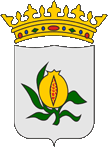 |
1492–1833, Wappen des Kastilischen Königreichs Granada – coat of arms of the Castilian Kingdom of Granada, Quelle/Source, nach/by: Wikipedia (DE) |
| Das Wappen der Communidad Andalusien wurde, wie die Flagge, am 30.12.1981 offiziell eingeführt. Es war im Jahre 1918 Infante Pérez de Vargas geschaffen wurden und wurde zuletzt 1923 abgeändert. Eigentlich ist es kein Wappen (es gibt keinen Schild), sondern ein Emblem. Es zeigt Herkules mit zwei Löwen zwischen zwei Säulen auf einer goldenen Kartusche mit der andalusischen Flagge. Auf der Flagge befindet sich eine goldene Inschrift: "Andalucía por sí, para España y la Humanidad" ("Andalusien für sich, für Spanien und die Menscheit"). Oberhalb der Säulen ein halbrundes Spruchband in den andalusischen Farben mit der goldenen Inschrift "Dominator Hercules Fundator" ("Herrscher Herkules der Gründer"). | The coat
of arms of the Communidad Andalusia was, like the flag, officially
introduced on 30st of December in 1981. It was created in 1918 by Infante
Pérez de Vargas and was last amended in 1923. In reality it is no coat of arms
(there is no shield), but an emblem. It shwos Hercules with two lions
between two columns on a golden cartouche with the andalusian flag. On the flag is placed a golden inscription: "Andalucía por sí, para España y la Humanidad" ("Andalusia for itself, for Spain and the humanity"). Above the columns a half-round banner in andalusian colours with the golden inscription "Dominator Hercules Fundator" ("Ruler Hercules the founder"). |
| Herkules soll im Verlauf seiner Abenteuer in Cádiz (dem antiken "Gadir") gewesen sein und gilt als Gründervater des Landes. Die beiden Löwen verkörpern Kraft und Instinkt, gelten aber auch als Symbole des siegreichen Christentums. Die beiden "Säulen des Herkules" (eigentlich die beiden Felsspitzen zu beiden Seiten der Meerenge von Gibraltar). Sie gelten als Symbol des überseeischen Einflusses von Spanien. | Hercules
should have been in Cádiz (the antique "Gadir") during his adventures and he
is something like the founder of the country. The lions embody power and
instinct, but they are even seen as symbols of the victorious Christianity. The "Columns of Hercules" (actually the both rocks on both sides of the Strait of Gibraltar) are the symbol for the transoceanic influence of Spain. |
| Quelle/Source: Wikipedia (ES), Volker Preuß | |
|
Die autonomen Regionen Spaniens – The autonomous Regions of Spain: Interaktive Landkarte - clickable map |
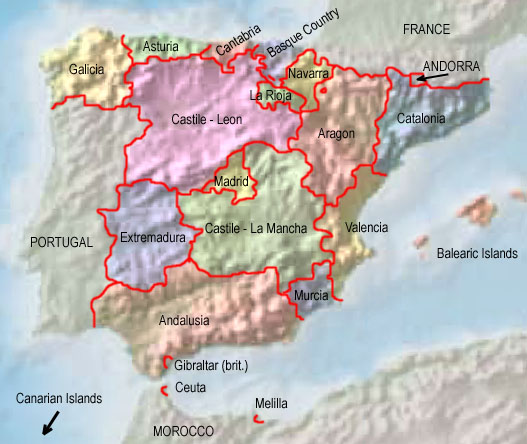 |
| Quelle/Source: Freeware, University of Texas Libraries, modyfied by: Volker Preuß |
| Zahlen und Fakten – Numbers and Facts: | |
|
|
|
|
|
|
|
|
|
|
|
|
|
|
|
|
|
Frühzeit
· Besiedlung durch Iberer, legendäres Königreich Tartessos (Tarsis) 11.–7. Jhd. v.Chr. · die Küste ist eine Kolonie Phöniziens 8.–6. Jhd. v.Chr. · griechische Kolonie Mainake an der Küste in der Nähe des heutigen Nerja ca. 600 v.Chr. · Einwanderung von Kelten, Vermischung mit den Iberern, Herausbildung der Keltiberer 3. Jhd. v.Chr. · die Küste ist eine Kolonie Kathagos 237 v.Chr. · das Reich von Karthago beginnt mit der Kolonisierung des Hinterlandes 226 v.Chr. · Ebrovertrag zwischen Rom und Karthago, der Fluss Ibero (Ebro) bildet die Grenze zwischen römischem und karthagischem Einflussgebiet 218–201 v.Chr. · Zweiter Punischer Krieg zwischen Rom und Karthago, das Römische Reich erwirbt die Besitzungen Karthagos in Iberien, Unterwerfung der ganzen Iberischen Halbinsel bis zum Jahre 19 v.Chr., römische Besiedlung, Romanisierung, später auch Christianisierung, das heutige Andalusien gehört zur römischen Provinz Baetica ca. 400 n.Chr. · Völkerwanderung, Durchzug von Alanen, germanischen Sweben, und Vandalen 411–429 · Vandalenreich im heutigen Andalusien 429 · Ankunft der Westgoten in Andalusien im Rahmen der Völkerwanderung, Vertreibung der Vanadalen nach Nordafrika, das heutige Andalusien wird Teil des Westgotenreiches 445 · Vandaleneinfall bei Portus Magnus Urci (das heutige Almería) 589 · Drittes Konzil von Toledo, das katholische Christentum wird zur Staatsreligion des Westgotenreichs erklärt 6. Jahrhundert · die Iberische Südküste kommt an das Oströmische Reich (Byzanz) 700–711 · Thronstreitigkeiten, die Partei des Thronfolgers Achila ruft zur Durchsetzung ihrer Interessen die Araber (zunächst Berber, "Moros" genannt) ins Land 711–714 · Vernichtung des Westgotenreichs durch von Nordafrika kommende Araber, die Westgoten ziehen sich nach Asturien und Kantabrien zurück, das heutige Andalusien wird von den Arabern besetzt, Arabisierung, Islamisierung, das besetzte Land auf der Iberischen Halbinsel wurde in der Folgezeit von den Eindringlingen "Al-Andalus" (wahrscheinlich "Land der Vandalen") genannt und gehörte zum Machtbereich der Omaijaden-Kalifen in Damaskus 722 · Schlacht von Covadonga, Fürst Pelayo von Oviedo (Asturien) schlägt die Araber, Beginn des Befreiungskrieges der christlichen Iberischen Völker gegen die Araber (Reconquista) 750 · Sturz der Omaijaden-Dynastie, Machtergreifung durch die Abbasiden, Flucht des letzten Omaijaden Abd Ar-Rahman von Damaskus auf die Iberische Halbinsel 756 · Truppen des Abd Ar-Rahman erobern Córdoba, Gründung des Arabischen Emirates von Cordoba auf der Iberischen Halbinsel 812 · Befreiung der Stadt Pamplona von den Arabern durch die Basken, Errichtung des christlichen Königreichs Pamplona (ab 905 Navarra) im Norden der Iberischen Halbinsel 856 · Befreiung von Leon von den Arabern 924 · Herausbildung des christlichen Königreichs Leon im Norden der Iberischen Halbinsel 929 · das Emirat von Cordoba wird zum Arabischen Kalifat Cordoba unter der Dynastie der Omajjaden umgebildet, die Berber und Araber bilden nur eine zahlenmäßig kleine Oberschicht, so dass es zunächst nicht möglich ist den Islam wie in der übrigen Welt auch auf der Iberischen Halbinsel mit erbarmungsloser Gewalt erfolgreich zu verbreiten, die Omaijaden gewähren daher Christen und Juden Glaubensfreiheit 1010 · Sturz der Omajjaden-Dynastie, Nachfolgestreitigkeiten, bis 1040 zerfällt das Reich in mehrere arabische Königreiche (z.B.: Malaga, Algeciras, Granada, Cordoba, Toldeo, Valencia, Zaragoza, Denia, Murcia und Badajoz) 1035 · Herausbildung des christlichen Königreichs Aragonien im Nordosten der Iberischen Halbinsel 1037 · Herausbildung des christlichen Königreichs Kastilien-Leon im Norden der Iberischen Halbinsel 1083 · Befreiung von Madrid von den Arabern 1085 · Befreiung von Toledo von den Arabern, die arabischen Könige fühlen sich unter Druck gesetzt und rufen die Almoraviden ins Land, eine islamisch-religiöse Dynastie des Senhadscha-Berbervolkes aus Afrika 1086 · die Almoraviden unter Jussuf ibn Taschfin marschieren in den Arabisch-Islamischen Teil der Iberischen Halbinsel ein und übernehmen die Macht, es gelingt den Vormarsch der christlichen Heere zunächst zu stoppen, die erstarkte Arabisch-Islamische Macht schafft die Glaubensfreiheit für Christen und Juden ab 1094 · der legendäre kastilische Nationalheld El-Cid (el Campeador, eigentl. Rodrigo Díaz de Vivar, 1043-1099) erobert und befreit Valencia, nach seinem Tod (1099) wieder von den Arabern erobert 1118 · Befreiung von Saragossa (Zaragoza) von den Arabern, Befreiung von Tarragona von den Arabern 1125–1130 · die islamisch-religiöse Dynastie der Almohaden bereitet in Marokko den Sturz der Almoraviden-Dynastie vor 1130–1163 · siegreicher Krieg der Almohaden gegen die Almoraviden in Nordafrika 1137 · Aragonien verbindet sich mit der Grafschaft Barcelona 1147 · Einmarsch der der Almohaden unter Abd al-Mumin in den Arabisch-Islamischen Teil der Iberischen Halbinsel 1147 · Befreiung von Calatrava von den Arabern 1177 · Befreiung von Cuenca von den Arabern 1212 · Schlacht von Navas de Tolosa, triumphaler Sieg der Heere der christlichen Königreiche, Zerschlagung des Almohaden-Reichs, Gründung des Kastillischen Königreichs Jaén (in der Region von Jaén und Navas de Tolosa), Zerfall des ehemaligen Almohaden-Reichs in mehrere Kleinkönigreiche (z.B.: Cádiz, Sevilla, Córdoba, Algeciras, Málaga, Granada, Almería, Murcia), in Málaga, Granada und Almeria als Emirat Granada unter der Dynastie der Nasriden 1236 · Befreiung von Córdoba von den Arabern, Gründung des Kastillischen Königreichs Córdoba 1238 · Befreiung von Valencia von den Arabern 1243 · die Stadt Murcia wird durch Alfons X. von Kastilien und seinen Truppen von den Arabern befreit, Gründung des Kastillischen Königreichs Murcia 1246 · das Emirat Granada anerkennt die Oberhoheit von Kastilien-León und zahlt Tribute 1344 · Befreiung von Algeziras von den Arabern 1248 · Befreiung von Sevilla von den Arabern, Gründung des Kastillischen Königreichs Sevilla 1248 · Befreiung von Alicante und Cartagena von den Arabern 1262 · Befreiung von Cádiz von den Arabern 1462 · Befreiung von Gibraltar von den Arabern 1466 · Ali Abu al-Hasan, der Emir von Granada stoppt die Zahlungen der Tribute an Kastilien-León 1469 · Isabella I., Königin von Kastilien-León heiratet Ferdinand II., den Prinzen und Thronfolger von Aragónien 1479 · Krönung von Isabella und Ferdinand zu Königen von Spanien, Kastilien-Leon und Aragónien werden zu einem einzigen Land vereinigt 1481 · Spanien fordert die Wiederaufnahme der Tributzahlungen, Emir Abu al-Hasan greift Spanien im Frühjahr an, Wiederaufnahme des Krieges zwischen Spanien und dem Emirat Granada 1482 · Emir Abu al-Hasan flieht aus Granada, dessen Bruder Abu Abd-Allahi proklamiert sich zum neuen Emir, Abdallah – der Sohn von Abu al-Hasan – nimmt die Tributzahlungen an Spanien wieder auf und vertreibt Abu Abd-Allahi, jedoch stellt er danach die Tributzahlungen an Spanien wieder ein, Wiederaufnahme des Krieges 1485 · Befreiung von Málaga von den Arabern 1487 · Granada wird belagert 1492 · das Emirat Granada kapituliert im Februar, Gründung des christlichen Königreichs Granada, damit Beseitigung des letzten Brückenkopfes der Araber auf Europäischem Gebiet, Spanien gewährt zunächst Glaubensfreiheit für Moslems, die Juden werden gezwungen den christlichen Glauben anzuehmen oder das Land zu verlassen 1499 · die in Andalusien lebenden Moslems werden gezwungen den christlichen Glauben anzuehmen oder das Land zu verlassen, angeblich verlassen 3 Millionen Muslime das Land 16. Jahrhundert · die Küstenstädte erblühen auf Grund des zunehmenden Überseehandels mit den Kolonien Spaniens, Landwirtschaft und Handwerk erfahren durch die Vertreibungen jedoch einen wirtschaftlichen Niedergang 1525 · der Islam wird verboten 1567 · Verbot der maurischen Sprache und maurischer Gebräuche 1568 · Aufstand der Morisken (christlich getaufte Araber) 1609 · die Morisken werden vertrieben 17./18./19. Jahrhundert · im Zuge der zurückgehenden Bedeutung Spaniens als Kolonial- und Handelsmacht beginnt auch der Stern Andalusiens zu sinken 19. Jahrhundert · viele Andalusier wandern nach Katalonien oder ins Baskenland aus 1833 · die bis dato in Spanien bestehenden Teilkönigreiche und Regionen werden in Provinzen aufgeteilt, in Granada die Provinzen Málaga, Granada und Almeria, die Kastilischen Königreiche Murcia, Sevilla, Córdoba und Jaén werden ebenfalls in Provinzen umgewandelt 1936–1939 · Spanischer Bürgerkrieg, die Provinzen Sevilla und Córdoba kämpfen an der Seite der Franco-Truppen gegen die sozialistische Zentralregierung, Málaga kämpft bis 1937 auf Seiten der "republikanischen" sozialistischen Regierungstruppen, die "republikanischen" Gebiete Andalusiens kapitulieren am 28.03.1939 mit der sozialistische Zentralregierung in Madrid 20.11.1975 · Tod von General Francisco Franco 1976–1977 · Ost-Andalusien versucht Autonomie gegenüber Spanien zu erreichen, Zusage von Autonomie für ganz Andalusien 11.01.1982 · Andalusien erhält das Autonomiestatut innerhalb Spaniens (unter Zusammenfassung der Provinzen Huelva, Sevilla, Cádiz, Córdoba, Jaén, Málaga, Granada und Almeria), Gründung der "Autonomen Gemeinschaft Andalusien" |
|
early age
· settlement by Iberians, legendary Kingdom of Tartessos (Tarsis) 11th–7th cent. B.C. · the coast is a colony of Phenicia 8th–6th cent. B.C. · greek colony Mainake at the coast near the today’s Nerja ca. 600 B.C. · immigration of Celts, mix with the Iberians, evolution of the Celtiberians 3rd cent. B.C. · the coast ia a colony of Cathago 237 B.C. · the Empire of Carthago starts with the colonization of the hinterland 226 B.C. · Ebro Treaty between Rome and Carthago, the Ibero (Ebro) River is the frontier between Roman and Carthagian areas of influence 218–201 B.C. · Second Punic War between Rome and Carthago, the Roman Empire acquires the possessions of Carthago in Iberia, subjugation of whole Iberia until the year 19 B.C., Roman settlement, romanization, later even christianization, the today’s Andalusia belonges to the Roman province of Baetica ca. 400 n.Chr. · Great Transmigration (Migration Period), immigration of Alans, teutonic Suebs and Vandals 411–429 · Empire of the Vandals in the today’s Andalusia 429 · arrival of the Western Goth in Andalusia in context of the Migration Period, expulsion of the Vanadals to northern Africa, the today’s Andalusia becomes a part of the Empire of the Western Goth 445 · invasion of the Vandals near Portus Magnus Urci (the today’s Almería) 589 · Third Concile of Toledo, the catholic christendom becomes the state religion of the Empire of the Western Goth 6th century · the Iberian south coast comes to the East Roman Empire (Byzantium) 700–711 · throne succession quarrels, the party of the throne successor Achila calls for the Arabs to enforce their interests (initially Berbers, called "Moros") 711–714 · annihilation of the Empire of the Western Goth by from northern Africa coming Arabs, the Western Goth retreat to Asturia and Cantabria, the today's Andalusia becomes occupied by the Arabs, arabization, islamization, the occupied country on the Iberian Peninsula is in the afteryears called "Al-Andalus" (probably "Country of the Vandals") by the intruders and belonged to the sphere of influence of the dynasty of the Omaijade-Califs in Damascus 722 · battle of Covadonga, Prince Pelayo of Oviedo (Asturia) beats the Arabs, start of the liberation war of the christian Iberian nations against the Arabs (Reconquista) 750 · overthrow of the dynasty of the Omaijads, seizure of power by the Abbasids, escape of the last Omaijade Abd Ar-Rahman from Damascus to the Iberian Peninsula 756 · troops of Abd Ar-Rahman conquer Córdoba, establishment of the Arabian Emirate of Córdoba on the Iberian Peninsula 812 · liberation of Pamplona Town from the Arabs by the Basques, establishment of the christian Kingdom of Pamplona (since 905 Navarra) in the north of the Iberian Peninsula 856 · liberation of León from the Arabs 924 · development of the christian Kingdom of León in the north of the Iberian Peninsula 929 · the Emirate of Cordoba becomes transformed ot the Arabian Califate of Cordoba under the dynasty of the Omaijads, the Berbers and Arabs are only a numerical little upper class, in this way it is initially not possible to propagate the Islam on the Iberian Peninsula successfully like in the other world spheres with merciless power, the Omaijads grant from there freedom of religious beliefs for Christs and Jews 1010 · overthrow of the dynasty of the Omaijads, succession quarrels, until 1040 the empire disintegrates in several Arabian kingdoms (E.G.: Malaga, Algeciras, Granada, Cordoba, Toldeo, Valencia, Zaragoza, Denia, Murcia und Badajoz) 1035 · development of the christian Kingdom of Aragon in the northeast of the Iberian Peninsula 1037 · development of the christian Kingdom of Castile-Leon in the north of the Iberian Peninsula 1083 · liberation of Madrid from the Arabs 1085 · liberation of Toledo from the Arabs, the Arabian king see themselves under pressure and call for the Almoravids, an islamic religious dynasty of the people of the Senhadsha Berbers in Africa 1086 · the Almoravids under Jussuf ibn Tashfin march in the Arabian islamic part of the Iberian Peninsula and seize the power, they are initially able to stop the advance of the christian armies, the stronger Arabian islamic might abolishes the freedom of religious beliefs for Christs and Jews 1094 · the legendary castile national hero El-Cid (el Campeador, really: Rodrigo Díaz de Vivar, 1043-1099) conquers and liberates Valencia, after his death (1099) conquered back by the Arabs 1118 · liberation of Saragossa (Zaragoza) from the Arabs, liberation of Tarragona from the Arabs 1125–1130 · the islamic religious dynasty of the Almohads prepares in Morocco the overthrow of the Almoravids dynasty 1130–1163 · victorious war of the Almohads against the Almoravids in north Africa 1137 · Aragon unites with the County of Barcelona 1147 · invasion of the Almohads under Abd al-Mumin in the Arabian islamic part of the Iberian Peninsula 1147 · liberation of Calatrava from the Arabs 1177 · liberation of Cuenca from the Arabs 1212 · battle of Navas de Tolosa, exulting victory of the armies of the christian kingdoms, annihilation of the empire of the Almohads, establishment of the Castilian Kingdom of Jaén (in the area of Jaén and Navas de Tolosa), disintegration of the former Almohads empire in several smaller kingdoms (E.G.: Cádiz, Sevilla, Córdoba, Algeciras, Málaga, Granada, Almería, Murcia), in Málaga, Granada and Almeria as Emirat of Granada under the dynasty of the Nasrids 1236 · liberation of Córdoba from the Arabs, establishment of the Castilian Kingdom of Córdoba 1238 · liberation of Valencia from the Arabs 1243 · Murcia Town becomes liberated from the Arabs by Alfons X. of Castile and his troops, establishment of the Castilian Kingdom of Murcia 1246 · the Emirate of Granada recognizes the supremacy of Castile-León and pays tributes 1344 · liberation of Algeziras from the Arabs 1248 · liberation of Sevilla from the Arabs, establishment of the Castilian Kingdom of Sevilla 1248 · liberation of Alicante and Cartagena from the Arabs 1262 · liberation of Cádiz from the Arabs 1462 · liberation of Gibraltar from the Arabs 1466 · Ali Abu al-Hasan, the Emir of Granada stops the payment of the tributes to Castile-León 1469 · Isabella I. Queen of Castile-Leon marrys Ferdinand II., the Prince and Throne-Successor of Aragon 1479 · coronation of Isabella and Ferdinand to Kings of Spain, Castile-Leon and Aragon become united to one country 1481 · Spain demands the revival of the tribute payments, Emir Abu al-Hasan attacks Spain in the spring, again onset of war between Spain and the Emirate of Granada 1482 · Emir Abu al-Hasan flees from Granada, his brother Abu Abd-Allahi proclaims himself to the new Emir, Abdallah – the son of Abu al-Hasan – restarts the tribute payments to Spain and banishes Abu Abd-Allahi, but after this he stops the tribute payments to Spain again, once more onset of war 1485 · liberation of Málaga from the Arabs 1487 · Granada id beleaguerd 1492 · the Emirate of Granada capitulates in February, establishment of the christian Kingdom of Granada, in this way elimination of the last bridgehead of the Arabs on European territory, Spain grants initially freedom of religious beliefs for the Muslims, the Jews become forced to adopt the christian believe or to leave the country 1499 · the in Andalusia living Muslims become forced to adopt the christian believe or to leave the country, ostensibly leave 3 millions of Muslims the country 16th century · the coastal places bloom because of the rising overseas trade with the colonies of Spain, however agriculture and craft see by the expulsions an economical decline 1525 · the Islam becomes prohibited 1567 · prohibition of the moresque language and moresque customs 1568 · revolt of the Moriscos (christian baptized Arabs) 1609 · the Moriscos become banished 17th/18th/19th century · in context of the descending importance of Spain as colonial and trade might starts the descend of the star of Andalusia 19th century · many Andalusians emigrate to Catalonia or to Basque Country 1833 · the until that point in time in Spain existing partial kingdoms and regions become divided in provinces, in Granada the provinces of Málaga, Granada and Almeria, the Castile Kingdoms of Murcia, Sevilla, Córdoba and Jaén become likewise transformed in provinces 1936–1939 · Spanish civil war, the provinces Sevilla and Córdoba fight on the side of the troops of General Franco against the socialistic central government, Málaga fights until 1937 on the side of the "republican" socialistic governmental troops, the "republican" territories in Andalusia surrender on 28th of March in 1939 together with the socialistic central government in Madrid 20th of November 1975 · death of General Francisco Franco 1976–1977 · East Andalusia trys to gain autonomy against Spain, promise for autonomy for whole Andalusia 11th of January 1982 · Andalusia gets the statute of autonomy within Spain (by summary of the provinces of Huelva, Sevilla, Cádiz, Córdoba, Jaén, Málaga, Granada and Almeria), establishment of the "Autonomous Community of Andalusia" |
| Quelle/Source: Wikipedia (EN), World Statesmen, Volker Preuß |
| Für die
Herkunft des Namens "Andalusien", das von den Arabern "Al-Andalus" genannt
wurde, gibt es keine plausible Erklärung, jedoch viele Theorien: 1.) Theorie
nach Reinhardt Dozy: 2.)
Theorie nach Heinz Halm: 3.)
weitere Theorie: |
To
clarify the origin of the name "Andalusia" – which was named by the Arabs
"Al-Andalus" – there is none plausible explanation, but many theories: 1.) Theory by
Reinhardt Dozy: 2.)
Theory by Heinz Halm: 3.)
further theory: |
| Quelle/Source: Wikipedia (DE) | |